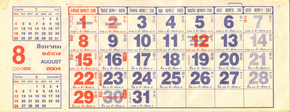Thai calendar
In Thailand, two main calendar systems are used alongside each other: the Thai solar calendar, based on the Gregorian calendar, used for official and most day-to-day purposes, and the Thai lunar calendar (a version of the Buddhist calendar, technically a lunisolar calendar), used for traditional events and Buddhist religious practices.

The use of the solar calendar was introduced in 1889 by King Chulalongkorn (Rama V), replacing the lunar calendar in official contexts. Originally placing the beginning of year on 1 April, this was changed to 1 January in 1941, so the days and months now correspond exactly to the Gregorian calendar. Numbering of the years follow the Buddhist Era, introduced in 1913 to replace the Rattanakosin Era, which in turn replaced the Chula Sakarat in 1889. The reckoning of the Buddhist Era in Thailand is 543 years ahead of the Common Era (Anno Domini), so the year 2020 CE corresponds to B.E. 2563.
The lunar calendar contains 12 or 13 months in a year, with 15 waxing moon and 14 or 15 waning moon days in a month, amounting to years of 354, 355 or 384 days. The years are usually noted by the animal of the Chinese zodiac, although there are several dates used to count the New Year.
As with the rest of the world, the seven-day week is used alongside both calendars. The solar calendar now governs most aspects of life in Thailand, and while official state documents invariably follow the Buddhist Era, the Common Era is also used by the private sector. The lunar calendar determines the dates of Buddhist holidays, traditional festivals and astrological practices, and the lunar date is still recorded on birth certificates and printed in most daily newspapers.
Calendars

- Red numerals mark Sundays and public holidays in Thailand.
- Buddha images mark Buddhist Sabbaths, Wan Phra (วันพระ).
- Red tablets with white Chinese characters mark the New and Full Moons of the Chinese calendar, which typically differ by one day from those of the Thai.
- Thai lunar calendar dates appear below the solar calendar date.
Birthdays
Mundane astrology figures prominently in Thai culture, so modern Thai birth certificates include lunar calendar dates, and the appropriate Chinese calendar zodiacal animal year-name for both Thai Hora (โหราศาสตร์, ho-ra-sat) and Chinese astrology. Thai birth certificates record the date, month and time of birth, followed by the day of the week, lunar date, and the applicable zodiac animal name. Thai traditionally reckon age by the 12-year animal-cycle names, with the twelfth and sixtieth anniversaries being of special significance; but the official calendar determines age at law.
For instance, 12 August 2004 was observed without regard to the lunar date as Queen Sirikit's birthday, a public holiday also observed as Thai Mother's Day. Her zodiacal animal is the Monkey and her traditionally significant sixtieth anniversary year was 1992. Born on a Friday, her auspicious birthday colour is blue. Thai auspicious colours of the day are given in the table of weekdays, followed below it by a link to the Buddha images for each day of the week.
Weeks
A week (สัปดาห์, sapda or सप्ताह, สัปดาหะ, sapdaha from Sanskrit "seven") is a 7-day period beginning on Sunday and ending Saturday.[1]
Days of the week are named after the first seven of the nine Indian astrological Navagraha; i.e., the sun, moon, and five classical planets.
| English name | Thai name | Thai Pronunciation | Colour | Sanskrit word | Planet |
|---|---|---|---|---|---|
| Sunday | วันอาทิตย์ | wan aathít | red | Aditya | Sun |
| Monday | วันจันทร์ | wan chan | yellow | Chandra | Moon |
| Tuesday | วันอังคาร | wan angkhaan | pink | Angaraka | Mars |
| Wednesday | วันพุธ | wan phút | green | Budha | Mercury |
| Thursday | วันพฤหัสบดี | wan phrɯ́hàtsàbɔɔdii | orange | Brihaspati | Jupiter |
| Friday | วันศุกร์ | wan sùk | blue | Shukra | Venus |
| Saturday | วันเสาร์ | wan sǎo | purple | Shani | Saturn |
Note: Colours are those considered auspicious for the given days of the week, that of Wednesday day being green and of Wednesday night, light green. Of Buddha images representing episodes (ปาง) from his life, there is one that represents a week and others for each day of the week: Monday has three options that are similar and Wednesday, entirely different ones for day and night.[2]
Thai representations of the planets in deity form are below:
 Phra Athit
Phra Athit Phra Chan
Phra Chan Phra Angkhan
Phra Angkhan Phra Phut
Phra Phut Phra Rahu
Phra Rahu Phra Phruehat
Phra Phruehat Phra Suk
Phra Suk Phra Sao
Phra Sao
Weekends and holidays
Saturdays and Sundays (Thai: เสาร์-อาทิตย์ sao athit) are observed as legal non-workdays (วันหยุดราชการ, wan yut ratchakan) and are generally shown on calendars in red, as are public holidays. Since 1996 and subject to declaration by the Cabinet of Thailand, public holidays that fall on weekends are followed by Substitution days (วันชดเชย, wan chot choei) generally shown in a lighter shade of red, as shown above for Monday, 2 August 2004. Buddhist feasts that are public holidays are calculated according to the Thai lunar calendar, so their dates change every year with respect to the solar calendar. Lunar New Year and other feasts observed by Thai Chinese vary with respect to both, as these are calculated according to the Chinese calendar.
References
- Royal Institute Dictionary 1999 Archived 2009-03-03 at the Wayback Machine
- "Thai birth day colors and Buddha image". United States Muay Thai Association Inc. 16 October 2004. Retrieved 14 November 2009.
An innovation of the Ayutthaya period.